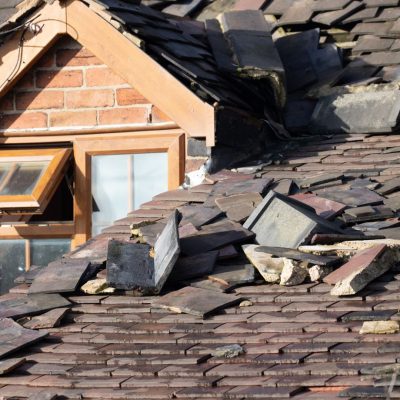When Mother Nature is in a bad mood and decides to take out her frustrations on your home, it can have costly results for you and your home. From a roof that may now be in need of repair to other problems you may encounter, getting these issues resolved as fast as possible is of the utmost importance. To know if poor weather damaged your home, here are a few signs that you should look for once the storm has vanished.
Missing or Broken Shingles
After bad weather, always go outside when it is safe to do so and take a look at your roof. If you notice shingles that are cracked, broken, or missing, you’ve got damage that will need to be repaired. If you let problems of this nature persist, you could eventually have more and more water damage to your home.
Often you will be able to assess this damage from the ground. Missing shingles should be obvious when you look up at your roof, particularly if there is a large patch of shingles missing. It can be harder to tell if shingles are simply cracked or loose. If you noticed severe wind during your last storm, it may be worth your time and money to have a roofing specialist come and inspect your roof.
Additional signs that your shingles were damaged during intense weather may be if you notice new leaks in your ceiling, if you find shingles on your lawn, or if your home is inexplicably draft, particularly on upper levels.
Loose Guttering
While you have been busy inspecting your roofing for potential damage, don’t forget to also pay attention to your home’s gutters. Should they be loose or suddenly not be as straight as before the bad weather hit, tend to this at once. When gutters become blocked or loose, the water that spills over could result in foundation damage, roof damage, or other problems.
You will be able to tell obvious rain gutter issues if you notice that part of it is detached from your roof or if it is not draining water properly. If you see large puddles around the foundation of your home, this can be a sign that your gutters are either loose or need to be cleared. If you are uncomfortable climbing on a ladder to check your gutters you can gently tap them with something like a rake to see if they are loose or not.
Gutter damage should be repaired as quickly as possible to prevent further damage from occurring to your home, particularly your foundation, during the next big rainstorm.
Water Stains on Walls
Even if an interior or exterior wall has but a very small crack, this can lead to water damage inside your home. To see if this is something you will be dealing with, examine your home’s interior and exterior walls for water stains or areas that appear to be damp. Oftentimes you can trace a leak to its exact origin and the area of your home that is leaking. However, sometimes it may be difficult to find the source of the leak. If you only noticed it during a recent storm it could be that the damage is new.
Even small leaks can lead to structural damage to your home. Additionally, leaks predispose your home to dangerous types of mold that may be difficult to get rid of. Don’t procrastinate in making whatever repairs are needed.
Chipped Paint or Plaster
Should you notice chipped paint or plaster that was not there prior to the storm, this likely indicates a serious impact occurred to an exterior wall. You may also likely notice some new water leaking in that area as well. Often if you go outside to investigate and notice a spider-web pattern of cracks on a wall, this usually means your home’s insulation was impacted. If this is the case it means that you need to repair the wall all the way through. A very common problem for property owners following a hurricane, this is one problem that should not be overlooked.
Check Your Windows
It is fairly common for windows to be damaged in a variety of storm types. Anything from severe rain to tornadoes or hurricanes to blizzards can put your windows at risk. Check all of the windows in your home after intense storms to see if you might need them repaired or replaced, especially if you were expecting intense winds during the storm. First look at the caulking around the window to ensure it is still sealed. Next, make sure there are no cracks or chips in the glass from flying debris. If you don’t notice any leaks through your window or drafts coming from it, your windows are likely fine.
When a big storm rolls in, whether it was expected or not, there is always a chance that it can damage your home at varying levels of severity. If you inspect your home and are not sure if something you noticed is due to storm damage, always call in experts who specialize in storm repairs to answer your questions and help you with the repairs. Repairs left unchecked can put your home at further risk of damage in even more expensive ways. Since it’s always better to be safe rather than sorry, taking these steps will give you peace of mind and let the repair process begin more smoothly.


